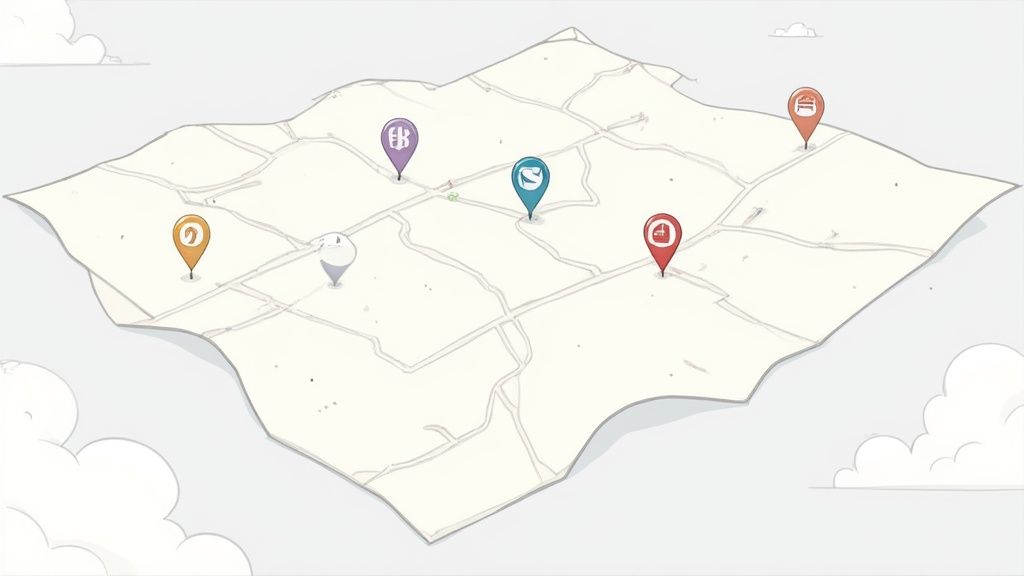How to Create a Product Roadmap: Essential Guide
Learn how to create a product roadmap that aligns strategy and inspires teams. Follow our proven guide to drive business success.

The Evolution of Modern Product Roadmaps

Product roadmaps have changed dramatically. They've gone from static documents focused on features to dynamic tools centered on strategy. This shift reflects a better understanding of how to guide product development in today's competitive market.
A product roadmap is much more than a simple feature timeline. It's a strategic document outlining the vision, strategy, goals, and timeline for a product's development. Its evolution mirrors the growth of the tech industry and changing market demands.
From Static Plans to Agile Processes
Early product roadmaps were often static, linear plans. They covered long periods and primarily focused on feature delivery. As markets became more dynamic, companies realized that rigid plans hindered innovation and responsiveness.
By the early 2000s, many organizations started adopting agile methodologies. Agile emphasizes incremental progress, customer feedback, and continuous improvement. By 2020, approximately 70% of product teams in North America and Europe had adopted agile practices. This shift was driven by the need to quickly adapt to changing customer needs and global trends. You can learn more about building product roadmaps at Product School. This adaptability is key for staying competitive.
To illustrate the key differences between traditional and modern product roadmaps, let's take a look at the table below. It summarizes the evolution of these essential planning tools.
Evolution of Product Roadmaps
A comparison of traditional vs. modern product roadmap approaches
| Characteristic | Traditional Roadmaps | Modern Roadmaps |
|---|---|---|
| Focus | Features | Outcomes & Strategy |
| Timeframe | Long-term, fixed | Short-term, flexible |
| Adaptability | Low | High |
| Collaboration | Limited | Extensive |
| Metrics | Output-driven (features shipped) | Outcome-driven (user engagement, revenue, etc.) |
As you can see, modern roadmaps prioritize strategic alignment and adaptability. This shift has significantly improved the effectiveness of product development.
The Shift in Focus: Why Outcomes Matter
Traditional roadmaps often fell short by treating products like construction projects. They emphasized what and when features would be delivered, not why. This created a disconnect between development and business goals. Modern roadmaps, on the other hand, prioritize outcomes over outputs. They focus on the desired results, such as increased user engagement or improved conversion rates.
Embracing Flexibility in a Changing Market
Modern product roadmaps embrace flexibility. They recognize that markets and customer needs shift quickly. This adaptability allows for adjustments and pivots without losing sight of the overall product vision. A flexible roadmap helps product teams navigate the ever-changing market.
Inspiring Teams and Driving Business Results
An outcome-driven approach promotes a shared understanding of the product’s purpose. This helps teams make smart decisions about feature prioritization. Modern roadmaps also emphasize collaboration and transparency, involving stakeholders throughout the process. This fosters buy-in and alignment with the product vision. By focusing on the "why" and embracing change, modern product roadmaps inspire teams and drive results, ultimately leading to successful products.
Crafting Your Product Vision That Actually Inspires
A compelling product vision is essential for a successful product roadmap. It acts as a guiding star for your team, providing direction and purpose. Think of your product vision as the ultimate destination, while your roadmap is the journey to get there.
Defining a Vision That Resonates
Creating a strong product vision isn't about simply listing features. It's about articulating the core purpose behind your product – the why. It should clearly communicate the value your product brings to users and how it solves their problems. This vision needs to resonate with everyone involved, from executives to developers. For example, "Empower teams to achieve their full potential through seamless collaboration and efficient project execution" is much more inspiring than "Build the best project management software." The former emphasizes the value provided to the user.
Market Research: Informing Strategy, Not Confirming Bias
Effective market research is crucial for grounding your product vision in reality. It involves understanding the market landscape, identifying your target audience, and discovering their unmet needs. Be wary of conducting research that merely confirms pre-existing biases. Instead, strive for objective data collection and analysis. Utilize techniques like user interviews, surveys, and competitor analysis to gain valuable insights. This ensures your product vision aligns with actual market demands.
Aligning with Broader Company Objectives
Your product roadmap shouldn't exist in isolation. It needs to align with the overarching goals of your company. This ensures that your product's development contributes to the overall success of the business. However, avoid simply creating a departmental wish list. Instead, clearly identify how your product vision supports broader company objectives. For example, if your company aims to expand into a new market, your product roadmap could prioritize features that cater to that specific market segment. This creates a shared sense of purpose across teams. For more insights on launching products successfully, check out this article: How to create a successful product launch that drives sales.
Identifying Strategic Themes
Strategic themes are high-level categories that organize your roadmap into meaningful initiatives. They group related features and activities, providing a framework for development efforts. These themes should focus on what customers truly value, not just internal jargon or technical features. Examples of strategic themes include "Improving user onboarding," "Enhancing platform security," or "Expanding into new markets." Focusing on these themes helps prioritize features and keeps the customer at the forefront. By aligning your roadmap with a compelling vision, informed by market research, and connected to company objectives, you create a powerful guide for your product’s development. A modern, data-driven approach utilizes tools to analyze market trends and customer data, enhancing product strategy and prioritization. Learn more about product roadmaps here. This ensures your product delivers real value to customers and contributes to your business's overall success.
Prioritization Techniques That End Feature Debates

Creating a product roadmap involves more than just brainstorming features. It requires a robust prioritization process to ensure you're building the right things at the right time. This is especially important when gathering input from multiple stakeholders, each with their own agendas. Prioritization frameworks offer a structured approach to navigate these discussions and arrive at data-driven decisions.
Understanding the Need for Prioritization
Gathering requirements from various sources is essential for building a successful product. However, this process can easily lead to an overwhelming number of suggestions. Without a system for prioritizing these requests, product roadmaps can become unmanageable and lose focus. This can result in feature bloat, where products become overloaded with additions that don't contribute to the core value. This is why prioritization frameworks are so important.
Introducing Key Prioritization Frameworks
Several prioritization frameworks help product teams objectively evaluate potential features. These frameworks move beyond subjective opinions and provide a structured approach to decision-making.
RICE Scoring: RICE stands for Reach, Impact, Confidence, and Effort. Each potential feature is scored across these four factors, resulting in a final RICE score. This score offers a quantifiable method for comparing features and prioritizing those with the highest potential ROI.
Value vs. Effort Mapping: This visual framework plots features on a graph based on their perceived value and estimated effort. Features falling into the high-value, low-effort quadrant are ideal candidates for prioritization.
Opportunity Scoring: This framework focuses on the potential opportunities each feature addresses. Factors considered might include market size, revenue potential, and competitive advantage.
Balancing Competing Priorities
Prioritization isn't a simple task. Product teams often grapple with balancing short-term gains with long-term strategic initiatives. Addressing technical debt is crucial, but it often competes with the desire for new features. Customer requests can also conflict with broader business goals. Prioritization frameworks help navigate these trade-offs by providing a clear and objective basis for decision-making.
Managing Stakeholder Pressure
Stakeholder pressure is a constant in product development. Executives, sales teams, and customers can strongly advocate for certain features. Learning to decline requests constructively is a critical skill for product managers. This involves explaining the rationale behind prioritization decisions and offering alternative solutions when possible. Maintaining positive stakeholder relationships, even when requests aren't immediately fulfilled, is paramount. Open communication and transparency regarding the product roadmap, such as using tools like Saylo for customer feedback, are key.
Practical Examples and Techniques
Imagine a customer requesting a complex new feature. While it benefits a small group, the effort involved is considerable. A Value vs. Effort mapping exercise can visually demonstrate why the feature isn't a high priority compared to other initiatives with a higher value-to-effort ratio. Another example involves balancing technical debt with new feature development. Allocating a set percentage of each development cycle to technical debt ensures that the underlying platform remains stable and maintainable as new features are introduced.
From Chaos to Coherence
Effective prioritization turns numerous feature requests into a coherent product roadmap. By employing these frameworks, product teams can create roadmaps aligned with executive vision and development team capacity. This promotes buy-in, transparency, and ultimately, successful products that deliver genuine customer value.
Selecting Roadmap Formats That Drive Alignment
Choosing the right product roadmap format is crucial for clear communication and team alignment. The format you select significantly impacts how your strategy is understood and executed. A visually appealing roadmap is a good start, but the underlying structure must serve the specific needs of your organization.
Matching Formats to Organizational Needs
Different roadmap structures cater to various organizational needs. Here are a few common formats:
Timeline-based Roadmaps: These roadmaps visually represent features and initiatives against a timeline. They offer a clear view of planned releases and deadlines. This format is useful for aligning teams around a schedule. However, it can become rigid in fast-paced, dynamic environments.
Theme-oriented Roadmaps: These roadmaps group initiatives by strategic themes, such as "Improving User Engagement" or "Expanding into New Markets." This format highlights the why behind the what, fostering a shared understanding of strategic goals.
Now/Next/Later Roadmaps: This simple format categorizes initiatives based on their timing: what's currently in progress, what's planned next, and what's further down the line. It’s a great way to communicate short-term priorities while maintaining flexibility.
Adapting Detail and Time Horizon
Successful product leaders tailor their roadmaps to their audience. An executive view focuses on high-level strategic outcomes and a longer time horizon. A team view, however, provides more granular detail and focuses on near-term execution. For example, an executive roadmap might show "Launch New Mobile App" in Q2 2024, while the corresponding team roadmap details specific features and sprints leading up to that launch.
Evaluating Roadmapping Tools
Many tools exist to create and manage product roadmaps. When choosing a tool, consider these key factors:
Collaboration: Does the tool facilitate easy communication and feedback among team members? Tools like Jira and Azure DevOps can be integrated for better collaboration.
Visualization: Does it offer flexible visualization options to suit different roadmap formats and audience needs?
Development Integration: Does it integrate with your development tools? This can streamline workflows and ensure everyone stays informed. Saylo offers a centralized platform for feedback, roadmapping, and communication.
To help you choose the right tool, we've put together a comparison table outlining some popular options:
To help you choose the right roadmapping tool, we've compiled a comparison of popular options:
Product Roadmap Tool Comparison: Analysis of popular roadmapping tools by key features and use cases
| Tool | Best For | Key Features | Limitations | Pricing Range |
|---|---|---|---|---|
| Saylo | Centralized feedback and roadmapping | Collaboration features, flexible visualizations, integrates with development tools | Limited integrations with some niche tools | Contact for pricing |
| Productboard | Product strategy and prioritization | Centralized feedback collection, feature prioritization, roadmap visualization | Can be expensive for small teams | Starts at $49/month |
| Aha! | Roadmapping and strategic planning | Roadmap creation, feedback management, prioritization and goal-setting | Steeper learning curve | Starts at $59/month |
| Roadmunk | Visual roadmapping | Customizable roadmap views, feedback collection, prioritization tools | Can be pricey for smaller teams | Starts at $49/month |
| Trello | Flexible project management & feedback tracking | Customizable boards and cards, integrations | Not specifically designed for roadmapping | Free plan available, paid plans from $5/user/month |
This table highlights some key differences between roadmapping tools. Be sure to research which one best fits your needs.
Communicating Certainty and Maintaining Flexibility
Your roadmap shouldn't be set in stone. It's essential to communicate appropriate levels of certainty. The further out on the timeline, the less certain plans become. This is especially important in agile environments where adaptation is key. Using ranges for estimated dates, such as "Q2 2024" instead of "June 15, 2024," can help manage expectations and acknowledge the inherent uncertainty in product development.
Choosing the Right Format
The best roadmap format depends on your specific context. Here's a quick guide:
Stable Market, Long-Term Planning: Timeline-based
Dynamic Market, Short-Term Focus: Now/Next/Later
Emphasis on Strategic Themes: Theme-oriented
Need for Executive Alignment: Timeline-based or Theme-oriented (High-level)
Focus on Team Execution: Now/Next/Later or Timeline-based (Detailed)
Ultimately, the right format is the one that facilitates communication, drives alignment, and empowers your team to build successful products. Remember, your product roadmap is a living document that should evolve with your product.
Building Your Roadmap: A Step-by-Step Framework

Turning strategic thinking into a practical product roadmap is crucial for guiding your team's daily work. This framework provides a clear, step-by-step approach, incorporating best practices from successful product teams. It's about creating a roadmap that your team will actually find useful.
Defining the Timeframe and Horizon
First, establish the right timeframe for your roadmap. This depends largely on your market's dynamics. In fast-paced markets, a shorter timeframe, like quarterly or monthly, offers more flexibility. Longer timeframes, such as yearly or even multi-yearly, are more suitable for stable markets. This sets the stage for detailed planning.
Next, determine the "horizon" – how far into the future your roadmap extends. A shorter horizon prioritizes immediate needs, while a longer one encompasses broader strategic goals. Balancing these perspectives ensures both efficient execution and long-term vision.
Organizing Initiatives and Connecting to User Needs
Organize your initiatives into themes. These categories should reflect user needs and strategic objectives. Examples include "Improving User Onboarding," "Enhancing Platform Security," or "Expanding into New Markets." Thematic organization helps prioritize features and connect them to user value.
When selecting roadmap formats, consider collaborative design tools like Figma. Within each theme, list specific initiatives. Describe what you want to achieve, not just how. For instance, "Reduce user onboarding time by 50%" is better than "Implement new onboarding tutorial." Focusing on user outcomes emphasizes the purpose behind each feature.
Determining Success Metrics
Measuring success is crucial. Define clear metrics that assess outcomes, not just outputs. Focusing on outputs like "number of features shipped" can be misleading. Instead, track outcome-based metrics: user engagement, customer satisfaction, or revenue growth. These metrics demonstrate the true impact of your product.
Incorporating Feedback and Validation Points
Modern roadmaps are not static. Integrate feedback loops and validation points. This allows for adjustments based on user feedback, market changes, and new information. Regular reviews, such as weekly or monthly check-ins, can help assess progress and make necessary adjustments. This ensures your roadmap stays relevant and dynamic.
Avoiding Common Roadmapping Pitfalls
Even experienced teams make mistakes. Overcommitment leads to missed deadlines. Dependency blindness occurs when teams overlook interconnected tasks, causing delays. Capacity planning errors result in unrealistic timelines and overworked teams. Careful planning, realistic estimations, and ongoing communication can prevent these pitfalls.
From Vision to Actionable Plan
This framework helps you build a product roadmap that balances strategic vision with practical execution. It becomes a tool your team actively uses, not a forgotten document. Constantly evolving and adapting, it helps you build the right things at the right time. This leads to a successful product that meets user needs and business objectives. The roadmap translates broad strategic themes into concrete actions, guiding your team's daily work, making it both aspirational and actionable.
Communicating Your Roadmap For Maximum Buy-In
A well-crafted product roadmap is essentially useless if no one ever looks at it. Successful product leaders understand this and actively work to make their roadmaps engaging and understandable, turning them into tools that drive organizational alignment. This involves understanding the unique perspectives of different stakeholders and tailoring presentations accordingly.
Tailoring Your Message to Different Audiences
Presenting the same roadmap to engineers and executives simply won't be effective. Developers need the nitty-gritty details: technical specifications, implementation plans, and clear dependencies. Executives, on the other hand, are focused on the bigger picture: strategic outcomes, market impact, and return on investment.
For example, when discussing a new feature, developers need to understand the technical specifications involved. Executives, however, need to understand the business justification for the feature and its potential revenue impact. Therefore, it's essential to create tailored presentations that resonate with each audience's specific needs and priorities.
Crafting a Compelling Narrative
Your roadmap should tell a story. Don't just explain what you are building, explain why. Explain why this roadmap matters to your customers and to the business as a whole. This "why" connects individual features to the larger product vision and overarching company goals.
This approach transforms a simple list of features into a compelling narrative that everyone can grasp and get behind. This shared understanding is crucial for obtaining buy-in and fostering a sense of shared ownership across the organization.
Addressing Challenges and Managing Expectations
Presenting a roadmap often means fielding difficult questions and navigating pushback. Effective product leaders anticipate potential concerns and come prepared with well-reasoned responses. They also set realistic expectations about timelines and potential changes, acknowledging that product development is an iterative process. This transparent communication builds trust and minimizes the risk of miscommunication.
Maintaining Transparency and Facilitating Discussions
Transparency is paramount for a successful roadmap. Regular progress updates keep stakeholders informed and engaged. However, this shouldn't translate to excessive reporting overhead. Use tools like Saylo to streamline communication and provide easy access to the latest roadmap information.
Facilitating productive roadmap discussions is also crucial. These discussions should be opportunities to generate valuable input, not devolve into debates about individual features. Keep the focus on strategic alignment and user needs, not individual feature requests. Consider exploring resources like reducing customer churn and establishing a content creation workflow.
Real-World Examples and Practical Strategies
Imagine presenting your roadmap to the executive team. The focus should be on how the planned initiatives contribute to key business objectives, such as increasing market share or improving customer retention. Back up your claims with supporting data and market analysis. This strengthens the presentation and demonstrates the strategic thinking behind the roadmap.
For developers, the same roadmap should emphasize technical feasibility, implementation details, and dependencies between different features. This allows them to understand their specific role in executing the plan and anticipate potential roadblocks.
By mastering these communication strategies, product leaders can elevate their roadmaps. Instead of static documents, they become dynamic tools that drive alignment and generate buy-in, ultimately contributing to the creation of successful products. The roadmap becomes a living guide for development, fostering collaboration, and driving the achievement of shared goals.
Evolving Your Roadmap Without Losing Credibility

Markets shift, priorities change, and customer needs are always evolving. This means your product roadmap needs to be adaptable. Constant changes, however, can damage stakeholder trust. This section explores how you can maintain a living roadmap while keeping your credibility intact. Building a roadmap is not a set-it-and-forget-it task. It's a continuous process.
Establishing Regular Review Cadences
A living roadmap requires regular reviews. How often you review depends on your industry. Fast-paced industries might require weekly or bi-weekly reviews. Slower-moving markets may only need monthly or quarterly reviews. Consistent reviews keep your roadmap aligned with market conditions and your business objectives. They also provide a structured way to incorporate new data.
Incorporating Customer Insights
Customer feedback is crucial for good product development. Reacting to every piece of feedback, though, creates chaos and loss of focus. Look for patterns and trends in customer feedback instead. Prioritize changes that address major user needs and align with your product vision. This strategic approach allows you to value customer insights without constantly changing direction. A clear roadmap shows the way forward. For more on community building, check out this article: Strategies to build and grow a community for your SaaS.
Measuring Impact and Communicating Change
Measuring the real-world impact of your roadmap decisions is essential. Track important metrics. Examples include user engagement, conversion rates, and customer satisfaction. This helps you understand what's working and what's not. This data-driven approach validates necessary changes. It strengthens your credibility as a product leader.
When changes are needed, communicate them clearly. Explain why you’re making these changes and how they will benefit the product and the users. Open communication maintains stakeholder confidence. It prevents the sense of being jerked around by constant shifts. Clear communication ensures everyone understands the changes and why they matter.
Handling Major Pivots and Roadmap Retrospectives
Sometimes, market conditions demand a complete overhaul of the plan. These major pivots require careful planning and communication. Clearly explain the reasons for the change, the new path forward, and what results you expect. This transparency helps everyone understand and support the shift. Being upfront builds trust and reduces potential issues.
Regular roadmap retrospectives are also valuable. These reviews allow you to reflect on the roadmap process. Ask yourself: What worked well? What can be improved? What lessons did we learn? Continuously improving the process leads to increased efficiency and better results. This process also builds your credibility by showing your adaptability. Applying these strategies ensures a relevant roadmap in changing markets. This will strengthen your reputation as a thoughtful, adaptable product leader.
Ready to improve your product roadmap process? Want to keep your stakeholders informed? Saylo provides a centralized platform for feedback, roadmapping, and communication, helping you build better products together.
Article created using Outrank